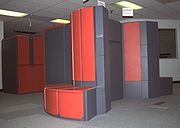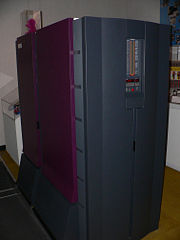
Cray Y-MP
Encyclopedia
The Cray Y-MP was a supercomputer
sold by Cray Research
from 1988, and the successor to the company's X-MP
. The Y-MP retained software compatibility with the X-MP, but extended the address registers from 24 to 32 bits. High-density VLSI ECL
technology was used and a new liquid cooling system was devised. The Y-MP ran the Cray UNICOS
operating system
.
The Y-MP could be equipped with two, four or eight vector processors, with two functional units each and a clock cycle time of 6 ns (167 MHz). Peak performance was thus 333 megaflops per processor. Main memory comprised 128, 256 or 512 MB of SRAM.
 The original Y-MP (otherwise known as the Y-MP Model D) was housed in a similar chassis to the horseshoe-shaped X-MP, but with an extra rectangular cabinet added in the middle (containing the CPU boards), thus forming a "Y" shape in plan view. The system could be configured with one or two Model D IOSs (Input/Output Subsystems) and an optional Solid State Disk (SSD) of 256 MB to 4GB capacity.
The original Y-MP (otherwise known as the Y-MP Model D) was housed in a similar chassis to the horseshoe-shaped X-MP, but with an extra rectangular cabinet added in the middle (containing the CPU boards), thus forming a "Y" shape in plan view. The system could be configured with one or two Model D IOSs (Input/Output Subsystems) and an optional Solid State Disk (SSD) of 256 MB to 4GB capacity.
The Model D Y-MP was superseded in 1990 by the Y-MP Model E, which replaced IOS Model D with IOS Model E, providing twice the I/O throughput. The Y-shaped chassis was dropped in favor of one or two rectangular cabinets (each with a separate connected cabinet containing the liquid cooling system), depending on configuration. Maximum RAM was increased to 2 GB and up to eight IOSs were possible. Model E variants included the Y-MP 2E, Y-MP 4E, Y-MP 8E and Y-MP 8I, the latter being a single-cabinet (I for Integrated) version of the two-cabinet 8E. The 2E and 4E were later available with optional secondary air cooling.
 The Y-MP M90 was a large-memory variant of the Y-MP Model E introduced in 1992. This replaced the SRAM of the Y-MP with up to 32 GB of slower, but physically smaller DRAM
The Y-MP M90 was a large-memory variant of the Y-MP Model E introduced in 1992. This replaced the SRAM of the Y-MP with up to 32 GB of slower, but physically smaller DRAM
devices. The Y-MP M90 was also available in variants with up to two, four or eight processors (M92, M94 and M98 respectively). Later, the model name was abbreviated to the Cray M90 series.
The Y-MP C90
series is described separately.

technology, based on the S-2 design acquired by Cray from Supertek Computers
in 1990. The EL was an air-cooled system with a completely different VMEbus
-based IOS. EL configurations with up to four processors (each with a peak performance of 133 megaflops) and 32 MB to 1 GB of DRAM
were available. The Y-MP EL was later developed into the Cray EL90
series (EL92, EL94 and EL98).
The Y-MP EL came in a cabinet much smaller than the traditional room-filling Cray systems—62×50×32 inches or 2010×1270×810 mm (height × width × depth) and 1400 lb/635 kg in weight—and could be powered from regular mains power.
Supercomputer
A supercomputer is a computer at the frontline of current processing capacity, particularly speed of calculation.Supercomputers are used for highly calculation-intensive tasks such as problems including quantum physics, weather forecasting, climate research, molecular modeling A supercomputer is a...
sold by Cray Research
Cray
Cray Inc. is an American supercomputer manufacturer based in Seattle, Washington. The company's predecessor, Cray Research, Inc. , was founded in 1972 by computer designer Seymour Cray. Seymour Cray went on to form the spin-off Cray Computer Corporation , in 1989, which went bankrupt in 1995,...
from 1988, and the successor to the company's X-MP
Cray X-MP
The Cray X-MP was a supercomputer designed, built and sold by Cray Research. It was announced in 1982 as the "cleaned up" successor to the 1975 Cray-1, and was the world's fastest computer from 1983 to 1985...
. The Y-MP retained software compatibility with the X-MP, but extended the address registers from 24 to 32 bits. High-density VLSI ECL
Emitter coupled logic
In electronics, emitter-coupled logic , is a logic family that achieves high speed by using an overdriven BJT differential amplifier with single-ended input, whose emitter current is limited to avoid the slow saturation region of transistor operation....
technology was used and a new liquid cooling system was devised. The Y-MP ran the Cray UNICOS
Unicos
UNICOS is the name of a range of Unix-like operating system variants developed by Cray for its supercomputers. UNICOS is the successor of the Cray Operating System . It provides network clustering and source code compatibility layers for some other Unixes. UNICOS was originally introduced in 1985...
operating system
Operating system
An operating system is a set of programs that manage computer hardware resources and provide common services for application software. The operating system is the most important type of system software in a computer system...
.
The Y-MP could be equipped with two, four or eight vector processors, with two functional units each and a clock cycle time of 6 ns (167 MHz). Peak performance was thus 333 megaflops per processor. Main memory comprised 128, 256 or 512 MB of SRAM.

The Model D Y-MP was superseded in 1990 by the Y-MP Model E, which replaced IOS Model D with IOS Model E, providing twice the I/O throughput. The Y-shaped chassis was dropped in favor of one or two rectangular cabinets (each with a separate connected cabinet containing the liquid cooling system), depending on configuration. Maximum RAM was increased to 2 GB and up to eight IOSs were possible. Model E variants included the Y-MP 2E, Y-MP 4E, Y-MP 8E and Y-MP 8I, the latter being a single-cabinet (I for Integrated) version of the two-cabinet 8E. The 2E and 4E were later available with optional secondary air cooling.

Dram
Dram or DRAM may refer to:As a unit of measure:* Dram , an imperial unit of mass and volume* Armenian dram, a monetary unit* Dirham, a unit of currency in several Arab nationsOther uses:...
devices. The Y-MP M90 was also available in variants with up to two, four or eight processors (M92, M94 and M98 respectively). Later, the model name was abbreviated to the Cray M90 series.
The Y-MP C90
Cray C90
The Cray C90 series was a vector processor supercomputer launched by Cray Research in 1991. The C90 was a development of the Cray Y-MP architecture. Compared to the Y-MP, the C90 processor had a dual vector pipeline and a faster 4.1 ns clock cycle , which together gave three times the...
series is described separately.

Y-MP EL
In 1992, Cray launched the cheaper Y-MP EL (Entry Level) model. This was a reimplementation of the Y-MP architecture in CMOSCMOS
Complementary metal–oxide–semiconductor is a technology for constructing integrated circuits. CMOS technology is used in microprocessors, microcontrollers, static RAM, and other digital logic circuits...
technology, based on the S-2 design acquired by Cray from Supertek Computers
Supertek Computers
Supertek Computers, Inc. was a computer company founded in Santa Clara, California in 1985 by Mike Fung, an ex-Hewlett-Packard project manager, with the aim of designing and selling low-cost minisupercomputers compatible with those from Cray Research....
in 1990. The EL was an air-cooled system with a completely different VMEbus
VMEbus
VMEbus is a computer bus standard, originally developed for the Motorola 68000 line of CPUs, but later widely used for many applications and standardized by the IEC as ANSI/IEEE 1014-1987. It is physically based on Eurocard sizes, mechanicals and connectors , but uses its own signalling system,...
-based IOS. EL configurations with up to four processors (each with a peak performance of 133 megaflops) and 32 MB to 1 GB of DRAM
Dram
Dram or DRAM may refer to:As a unit of measure:* Dram , an imperial unit of mass and volume* Armenian dram, a monetary unit* Dirham, a unit of currency in several Arab nationsOther uses:...
were available. The Y-MP EL was later developed into the Cray EL90
Cray EL90
The Cray EL90 series was an air-cooled vector processor supercomputer first sold by Cray Research in 1993. The EL90 series evolved from the Cray Y-MP EL minisupercomputer, and is compatible with Y-MP software, running the same UNICOS operating system...
series (EL92, EL94 and EL98).
The Y-MP EL came in a cabinet much smaller than the traditional room-filling Cray systems—62×50×32 inches or 2010×1270×810 mm (height × width × depth) and 1400 lb/635 kg in weight—and could be powered from regular mains power.

